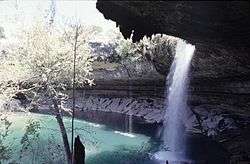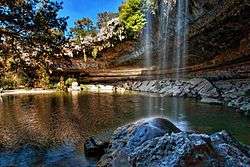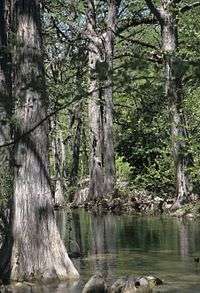Hamilton Pool Preserve


Hamilton Pool Preserve is a natural pool that was created when the dome of an underground river collapsed due to massive erosion thousands of years ago. The pool is located about 23 miles (37 km) west of Austin, Texas off Highway 71. Since the 1960s, Hamilton Pool has been a popular summer swimming spot for Austin visitors and residents. Hamilton Pool Preserve consists of 232 acres (0.94 km2) of protected natural habitat featuring a jade green pool into which a 50-foot (15 m) waterfall flows.
The pool is surrounded by large slabs of limestone that rest by the water's edge; large stalactites grow from the ceiling high above. The ceiling and surrounding cliffs of the grotto are home to moss, maidenhair fern and cliff swallows. The Ashe juniper (cedar) uplands of the preserve are home to the endangered golden-cheeked warbler.[1]
The natural pool and creek are not chemically treated, so water quality is monitored regularly and swimming is occasionally restricted. Hamilton Pool is part of the Balcones Canyonlands Preserve and is a protected environment.
History

Prior to the 19th century, the Tonkawa and Lipan Apaches lived in the area. In the mid-1860s, Morgan C. Hamilton owned the property now known as Hamilton Pool Preserve. His brother, Andrew Jackson Hamilton, evidently visited the grotto while serving as Texas governor (1865–66). In the 1880s, the Reimers' family, immigrants from Germany, bought the property to raise sheep and cattle. Legend says that their eight-year-old son discovered the collapsed grotto.
Although ranchers might have considered the grotto a safety hazard for their livestock, the Reimers soon realized its value as a recreational area and opened the property for public use. Around the turn of the 20th century, the site did not attract many visitors, but by the 1960s, and on into the 1980s, Hamilton Pool's popularity had increased. The land suffered from sheer numbers and few restrictions.
In addition to impact from the visiting public, cattle, sheep and goats grazed the delicate ecosystem for several decades, resulting in changes to the native vegetation. In 1980, the Texas Parks and Wildlife Department cited Hamilton Pool as the most significant natural area in rural Travis County. In 1985, Travis County purchased 232 acres (0.94 km2) from the Reimers family and implemented an aggressive land management plan to restore Hamilton Pool. Now, as a result of the restoration plan, the ecosystems of Hamilton Pool are recovering.
Ongoing land management practices at Hamilton Pool Preserve include prescribed burns, prairie restoration, endangered species surveys, biological inventories and water quality monitoring.[2]
Ecology
Flora
The preserve is home to the chatterbox orchid (Epipactis gigantea) and the eastern red bay (Persea borbonia).
Filming location
The 1990 movie The Hot Spot, with Jennifer Connelly and Don Johnson; the 2007 film Teeth; the 2010 film Predators; the 2011 film, The Tree of Life; and the 2015 music video for the song Charlie Gray by the Dallas-based indie-rock band Valise all filmed scenes at Hamilton Pool.
Access
- As of July 2015, access to the pool and river requires a $15 Travis County Park entry fee per vehicle, cash and local check only. The fee is $5 per vehicle if a passenger is a senior citizen of 62 years or more or a disabled vet (60%). The issued permit allows you access to all Travis County Parks for that day.
- Hamilton Pool Preserve has a capacity limit. As of May 2016, Travis County Parks requires visitors to make a reservation to enter Hamilton Pool Preserve between May 30-September 30. Passes can be sold out more than 2 weeks in advance.
- You can make your reservations online for a particular date. Choose from one of two time periods: 9 am - 1 pm, or 2 pm- 6 pm. You pay online for your reservation fee, and pay for your entrance fee with cash or local check when you arrive at the preserve.
- Reservations are not refundable. Only one vehicle allowed for each reservation. Each vehicle needs its own reservation. Once you make your reservation, you cannot reschedule for a different date. Swimming is not always allowed and it is not guaranteed with your reservation.
- Getting to the pool requires a steep quarter-mile trek downhill. There is no handicapped access available. Hiking shoes are recommended.
- No drinking water or concessions are available.
- There is no lifeguard on duty.
- There is no glass bottles or public displays of alcohol consumption permitted.
- The preserve is occasionally closed due to flooding or hazardous trail conditions. Call (512)264-2740 for updated information, recorded daily.
- The preserve opens at 9:00 am, and closes at 6:00 pm. Entry is not permitted after 5:30 pm, and all recreational activities end at 5:30 pm.
References
External links
| Wikimedia Commons has media related to Hamilton Pool Preserve. |
Coordinates: 30°20′32″N 98°07′37″W / 30.34227°N 98.12693°W
- Austin Explorer: Hamilton Pool Preserve
- Crake Productions: Central Texas; Hamilton Pool Preserve
- Wild Texas: Hamilton Pool Preserve
- Pictures of Hamilton Pool by Brian P. Barnes